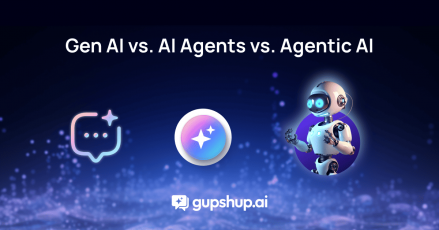Conversational Advertising Trends in 2024

The last couple of years have been a period of oscillation between innovation and introspection, especially within the advertising and marketing industry. As new and innovative advertising trends emerge daily, conversational AI chatbots and AI WhatsApp bots stand out, fundamentally reshaping how brands interact with customers.
This transformation, which includes a shift from traditional advertising to engaging, personalized communication, has altered marketing strategies industry-wide, ultimately enhancing the customer experience.
Let’s explore how these innovations are shaping the future of advertising and the critical challenges they aim to address.
Innovative Advertising Trends in 2024

We have curated a list of new advertising trends to help your businesses navigate several challenges and help you understand how Gupshup is an indispensable solution.
From Lead Forms to Conversational AI
Traditional lead forms are static and can disrupt the entire user experience.
Conversational AI chatbots and AI WhatsApp bots transform static forms into two-way conversations. How is it helpful? It significantly enhances user engagement and data collection without intruding on privacy.
As businesses adopt conversational AI, they benefit from efficiently managing a high volume of queries, improving customer satisfaction and retention.
36% of organizations have integrated chatbots into their operations, leading to a 67% increase in sales. This demonstrates chatbots’ significant impact on customer interactions and establishes them as key tools for advertisements and promotions.
Let’s look at an example:

Scenario 1: Lead Forms
A Company has a website where they offer digital marketing services. Their website has a lead form where visitors can enter their name, email address, phone number, and a brief message expressing their interest in digital marketing services.
Visitor fills out the lead form:
Name: John Doe
Email: johndoe@example.com
Phone Number: 123-456-7890
Message: “Interested in digital marketing services for my small business.”
After submitting the form, John Doe waits for a response. The company might take hours or even days to follow up via email or phone, which can lead to a potential customer’s loss of interest or engagement.
Let’s look at another scenario with conversational AI in the picture:
Scenario 2: Conversational AI via WhatsApp
Now, the company has integrated conversational AI into its website, allowing visitors to initiate conversations via WhatsApp. When visitors click the WhatsApp button, they’re greeted by a chatbot.
Visitor initiates a conversation:
Visitor: Hi, I’m interested in digital marketing services for my small business.
Chatbot: Hello John! I’m glad to hear that. Please tell me more about your business and your specific needs.
Visitor: Sure, I run a local bakery and want to improve my online presence and attract more customers through social media and Google ads.
Chatbot: That’s great! We offer a range of digital marketing services tailored for businesses like yours. Please provide your email address so we can send you more information and schedule a consultation.
In this scenario, the conversational AI immediately responds and engages the visitor in a personalized conversation. It gathers necessary information in real-time and can even promptly schedule follow-up actions like emails or consultations.
Navigating the Non-linear Customer Journey
The customer journey is no longer a simple, straight path. It has now become a complex, multi-touchpoint experience.
Customers interact with brands across various platforms and channels in a non-linear customer journey, often in non-sequential ways.
Technologies like Conversational AI Chatbots use advanced natural language processing and machine learning to understand and react to customer intents. It automates complex tasks and provides simple, seamless interactions. This approach helps brands maintain relevance and engagement and increases the likelihood of conversions.
Let’s look at an example –
Example: Non-linear Customer Journey
John researches smartphones online, sees an ad, visits a local store’s website, and then decides to shop in-store. He has questions about products and availability but limited resources to help him through.
How does a chatbot help in this situation?
- Assists John with product information and answers questions in real time.
- Provides detailed product information and answers John’s questions, aiding him in comparing features and making informed decisions about which smartphone to purchase.
- Continues to assist John by providing directions to the store, helping him schedule appointments, and offering additional support, ensuring a seamless transition from online to offline channels.
- After John makes a purchase, chatbots provide post-purchase support, such as order updates and warranty information, enhancing his overall satisfaction and loyalty to the brand.
The chatbot streamlines John’s journey, enhances his experience, and boosts conversions for the business.
Google’s U-Turn on Third-Party Cookie: What It Means for Businesses

Google’s decision to retain third-party cookies in its Chrome browser represents a significant shift in its approach to privacy and advertising.
Initially, Google had planned to phase out these cookies by 2024 as part of its Privacy Sandbox initiative, which aimed to enhance user privacy while still enabling targeted advertising. However, after facing considerable challenges and feedback from various stakeholders—including advertisers, publishers, and regulators—Google has opted to keep third-party cookies, at least for the time being.
This decision reflects Google’s struggle to balance user privacy with the needs of the advertising industry. While the Privacy Sandbox technologies showed promising results in testing, Google recognized that transitioning the entire digital ecosystem away from cookies would require more time and development.
As a result, rather than eliminating third-party cookies, Google plans to introduce a new user experience in Chrome that will give users more control over their privacy settings. This move is seen as a relief to many in the advertising industry who were concerned about the potential disruptions a cookie-less future would bring.
For businesses, this means that strategies centered around third-party cookies remain viable for the foreseeable future. However, it’s crucial to remain adaptable as Google continues to work on alternative privacy-preserving technologies.
In the meantime, companies should focus on enhancing transparency and user trust regarding data usage, which will be increasingly important as privacy concerns continue to evolve.
Use QR Codes for Seamless Digital Integration
QR codes are a practical tool to bridge the gap between physical products, print media, and digital content. Embedding QR codes in advertising materials or product packaging can help businesses direct consumers to additional online resources, such as instructional videos, promotional landing pages, or exclusive content.
This enhances the customer experience and provides a measurable method of tracking engagement and gathering data on consumer preferences and behaviors.
Here is how businesses can adopt this method –

Scan the QR code to access:
- Instructional Videos: Learn how to use our product like a pro with step-by-step tutorials.
- Promotional Landing Pages: Discover exclusive offers, discounts, and promotions tailored just for you.
- Behind-the-Scenes Access: Get a sneak peek into our manufacturing process and see how your favorite products are made.
Enhance Your Experience Today!
Increase Customer Engagement with Instagram Ads
With over 130 million users engaging with shopping posts monthly, Instagram provides businesses with a lucrative opportunity to drive direct sales through the platform.
The engagement rates for various types of Instagram content indicate the platform’s strong capacity to capture attention; for instance, carousel posts achieve an engagement rate of 1.08%, while Instagram Reels have an even higher engagement rate of 1.23% per post. This makes them one of the most engaging types of content on the platform.
Effective Instagram ads often include compelling visuals, direct calls to action, and links that take users straight to product pages or special offers, making them a critical tool in digital marketing strategies.
Consider this image:

With this, businesses can –
- Achieve Targeted Advertising: Reach your ideal audience with precision.
- Showcase Compelling Visuals: Captivate attention and tell your brand story.
- Display Direct Calls to Action: Swipe up to shop now!
- Lead Straight to Special Offers: Instant access to exclusive deals and promotions.
Monetizing Social Media Ad Campaigns with CTWA
Another trend businesses adopt more frequently is CTWA (Click to WhatsApp Advertising). CTWA makes social media ads more effective by allowing users to start a chat on WhatsApp directly from an ad with just one click. This feature simplifies connecting with a business immediately after seeing an ad, making it easier for users to get more information or make a purchase directly through a conversation on WhatsApp.
One major example of CTWA is the integration of Facebook Ads with WhatsApp. Advertisers use Facebook’s vast reach to funnel users directly into a WhatsApp conversation through a simple ad click.
For instance, a WhatsApp chatbot can handle initial inquiries and present engaging content, such as product options or booking forms, making the interaction efficient and personalized.
Businesses benefit from this trend, facilitating immediate communication, personalized interactions based on user data, and efficient lead generation. Moreover, CTWA also helps in building first party database.
For instance, CTWA can also re-engage customers who abandoned their shopping carts by sending personalized messages directly via WhatsApp, encouraging them to complete their purchases. This method helps reduce re-marketing costs and increases conversion rates by maintaining engagement within the same platform where the conversation started.

These conversational strategies are particularly effective because they use the familiarity and convenience of messaging apps, integrate seamlessly with social media platforms, and provide a direct link between advertising and customer interaction.
This can be used to refine marketing strategies and product offerings.
CPaaS Evolution and AI Integration
Communications Platform as a Service (CPaaS) is reshaping the digital landscape as an emerging trend in AI-driven advertising. CPaaS provides a framework that enables companies to add real-time communication features to their existing applications without building backend infrastructure and interfaces.
This trend is gaining traction rapidly because it allows businesses to directly integrate messaging, voice, and video communication capabilities into their software applications, leading to enhanced customer experiences.
Gupshup presents a powerful CPaaS solution that stands out for its AI capabilities and multilingual support. Gupshup’s platform enables seamless communication across various channels, ensuring businesses can engage with customers globally. The platform’s multilingual chatbots and AI-driven analytics allow for personalized customer interactions at scale. By integrating these advanced tools, companies can leverage Gupshup to create more dynamic and responsive advertising campaigns that resonate with a diverse customer base.
This means businesses can now easily cross language barriers, ensuring their marketing messages are not lost in translation, thereby improving global reach and customer satisfaction.
Conversational AI Revolution In Advertising
The advertising industry has already undergone significant transformations due to AI technologies. The integration of Generative AI, conversational AI, and augmented reality has completely changed how brands interact with their audiences, pushing the boundaries of personalized and immersive consumer experiences. This ongoing evolution continues to transform advertising, offering new ways for brands to engage with their audiences with remarkable efficiency and creativity.
Brands that have embraced these technologies are already experiencing a competitive edge, demonstrating the ability to captivate and retain customers. As AI technologies evolve, they continuously set new standards in the industry.
As we progress, the ethical landscape surrounding AI in advertising will continue to develop, ensuring that innovation aligns with responsible use. This dynamic period in advertising is about reshaping the entire approach to marketing in a digitally driven world.
Gupshup’s advanced AI solutions can help transform your advertising strategy and enhance customer engagement. Contact Gupshup today and take the first step towards harnessing the power of advanced conversational AI.




